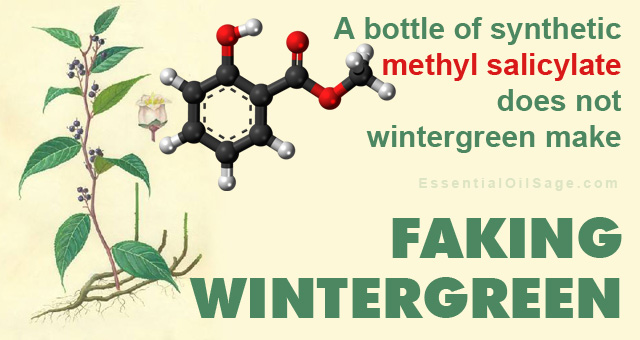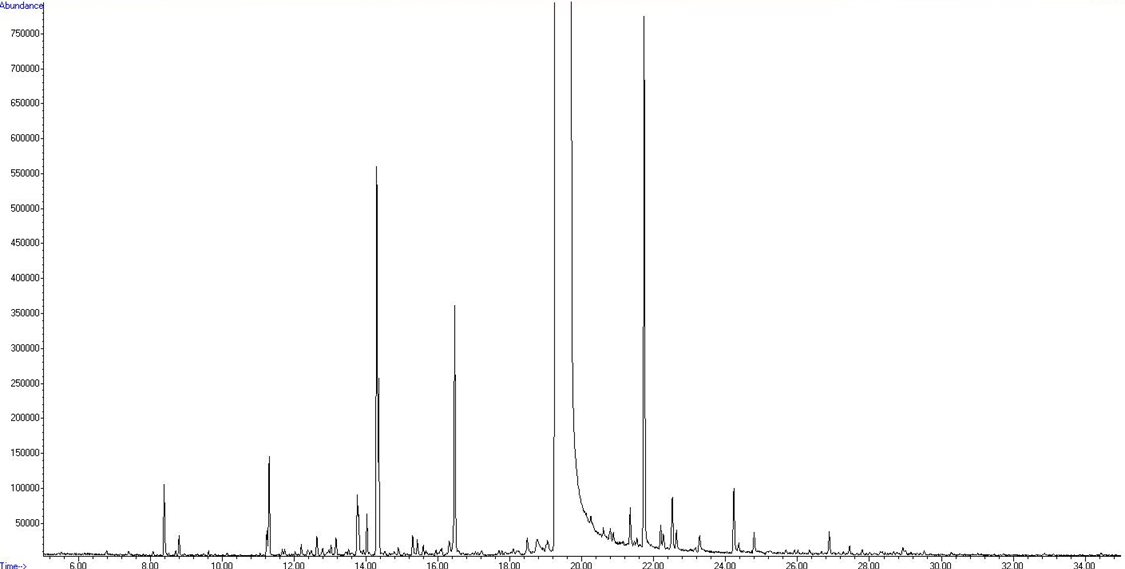
Search the internet and you will find that the chemical representation above is falsely identified as wintergreen. The symbol actually represents methyl salicylate. The vast majority of so-called wintergreen oil on the market is nothing more than methyl salicylate. Yet nature actually provides hundreds of compounds in true oil distilled from the wintergreen plant.
Young Living’s natural Wintergreen essential oil is one of the few examples of true wintergreen essential oil on the market.
Most retail, direct marketing, and internet sales of “wintergreen” are actually “fake wintergreen” or “synthetic wintergreen”. Natural Wintergreen is composed of mostly one component, methyl salicylate.
In natural Wintergreen methyl salicylate makes up 97-98% of the essential oil. In “synthetic or fake wintergreen” methyl salicylate makes up 99.0-99.8%. Synthetic wintergreen is made in a chemical factory with chemicals derived from petroleum crude oil.

GC-MS of Young Living Wintergreen essential oil. This meets the specifications of the ISO method.
Let’s look at Young Living natural Wintergreen first. The peak representing methyl salicylate is at about 20 minutes in the chromatogram. The natural component to the right at about 22 minutes is ethyl salicylate – both are esters that have a nice, pleasing aroma.
Natural Wintergreen also contains four other minor components: alpha-pinene (11 minutes), beta-pinene (13 minutes), 1,8-cineole (14 minutes), and linalool (16 minutes). The six components are listed in the international standard for natural wintergreen (ISO Method 21390). Young Living Wintergreen is natural wintergreen that conforms to these minimum standards.
At Young Living we can easily detect “fake wintergreen” with GCMS. Fake or synthetic wintergreen does not contain all 6 of the molecules mentioned in ISO Method 21390.
I’ve tested wintergreen oil from numerous companies. I nearly always find they are “synthetic” and not natural. Fake wintergreen usually contains synthetic by-products of the chemical reaction. These synthetic by-products are easily detected by GCMS (we purchased synthetic methyl salicylate to determine these synthetic by-products).
I even found a company who “faked” their synthetic wintergreen oil by adding a small amount of peppermint essential oil to make it look natural. These “perfumed” oils are disguised by saying “beautiful aroma” or “natural” when they really are not.
I found a “fake wintergreen” that contained synthetic by-products of chlorinated salicylate and methyl paraben? Some companies go to elaborate “disguises” to create better smelling oils. Unfortunately, their wintergreen oils are not natural—they just market them as being “natural”.
Natural wintergreen essential oil grows wild in North America and Greater China regions. It is my experience that nearly 100% of the natural wintergreen is grown and distilled in China and Tibet.
Each batch of Young Living natural Wintergreen essential oil is tested by GCMS, GC, polarimetry, FT-IR, densitometry, color, and aroma at our Quality Labs to ensure that you have “natural wintergreen” instead of the “fake wintergreen” that is sold by the others.
That’s the Seed-to-Seal difference.
Source: Dr Cole Wooley PhD, May 22, 2015
Related Posts

A significant portion of deaths during the 1918–1919 influenza pandemic my have been due to the newly popular aspirin (salicylates)…
https://academic.oup.com/cid/article/49/9/1405/301441
A Toddler Drank His Mom’s Essential Oils. This Is What Happened To His Brain